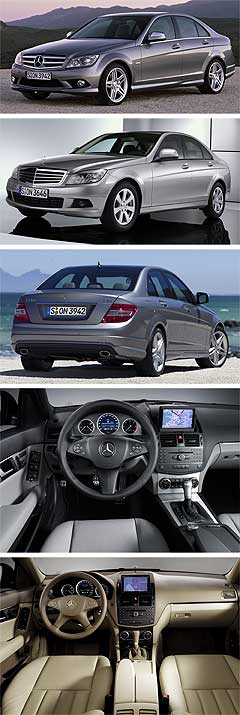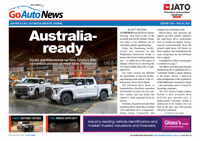Make / Model Search
Future models - Mercedes-Benz - C-ClassFirst look: Wraps off new C-class sedanMini S-class: The C-class borrows styling cues from its siblings. Merc’s volume-seller bigger, safer, more economical19 Jan 2007 MERCEDES-BENZ has unveiled its new C-class sedan, which arrive here in June. Borrowing styling cues from the R-class and S-class, the newcomer is slightly bigger than the current car with improved performance and economy, safety and dynamics. At launch five petrol and three turbo-diesel engines will be available – the C180K four-cylinder, C200K four-cylinder, C230 V6, C280 V6 and C350 V6 petrol engines and C200 four-cylinder CDi, C220 four-cylinder CDi and C320CDi V6 turbo-diesels. A new close-ratio six-speed gearbox will be offered in Europe with five-speed automatics available as well. The C350 carries over the 7G-tronic seven-speed automatic in the current car. The C-class is the most important Mercedes passenger car, representing 30 per cent of total global sales and it is the volume seller for the brand in Australia. Mercedes-Benz will also spin off a wagon, sports coupe and possibly a convertible from the new C-class platform as well as AMG variants. Like the current car, three trim levels will be offered – Classic, Elegance and Avantgarde. To distinguish the Classic, it will maintain the more traditional ‘gun-sights’ three-pointed star on the bonnet while upper-spec models will gain an SL-style three-pointed star in the grille. It is the first time the radiator grille has been used as a distinguishing feature of each model while 17-inch alloys are also expected to be standard on up-spec models while the Classic gains electric front seats, height and reach adjustable steering wheel, adaptive braking, seven airbags, foglights and multi-function steering wheel.. The Avantgarde’s grille has three extended, horizontal louvres and a big centrally positioned Mercedes star, normally a traditional design feature of sporty Mercedes models. To further emphasis the car’s performance an AMG sports kit is also offered with front and rear spoilers and AMG alloys. Inside the two-tone dashboard is more overtly sporty with silver-coloured bezels, black dial faces, white markings and glowing orange needles while the steering wheel is a multi-function four-spoke design. The colour display unit on the upper centre of the dashboard, which also operates the car’s navigation system, can be folded away when not required. Mercedes-Benz has also developed an intuitive BMW iDrive-type controller for in-cabin functions. At 4581mm in length, the sedan is 55mm longer than its predecessor. The car is also 42mm wider at 1770mm while the wheelbase has grown 45mm to 2760mm. Front and rear tracks have grown too 44mm at the front and 76mm at the rear. The bigger dimensions have delivered gains in cabin space with front shoulder room increased by 40mm.  From top: Avantgarde, Classic, Avantgarde rear, Avantgarde with AMG sports interior and Elegance interior. From top: Avantgarde, Classic, Avantgarde rear, Avantgarde with AMG sports interior and Elegance interior.Visually the C-class adopts a pronounced wedge-shape at the front, sweeping shoulder line and short boot. The C-class boast what Mercedes-Benz calls “agility control” suspension with situation-responsive shock absorber control, an intelligent light system with five different lighting functions. The intelligent light system offers bi-xenon headlamps with five different light settings including country mode, highway mode, enhanced foglights and cornering lights. The “agility control” suspension is based on an amplitude-dependent damping system: when driving normally with low shock absorber impulses, the damping forces are automatically reduced for a noticeable improvement in ride comfort - but without compromising handling. When shock absorber impulses are greater, at higher speeds or taking avoiding action, the system adopts maximum damping forces to stabilise the car. This technology is purely hydromechanical and requires no complex sensors or electronics. It is mainly based on a by-pass channel in the crank pin of the shock absorber and a control piston moving within a separate oil chamber. As part of the “agility control” system the steering is six per cent more direct than the previous model and the manual gearbox is a close-ratio unit. From September Mercedes-Benz will offer a sports mode package called “advanced agility”. This offer the driver a choice of two gearshift programs: sport and comfort. Within these programs the shock absorber for each wheel has infinitely variable electronic control. A newly developed speed-sensitive steering with a more direct ratio, variable centering and adaptation of the accelerator characteristics and automatic transmission shift points is also included in the package. Standard equipment includes a raft of passive and active safety features, including Pre-Safe, Adaptive Brake, which is based on similar technology in the S-class, seven airbags, including a driver’s knee bag, front and rear seatbelt pretensioners and belt-force limiters and active headrests. Mercedes-Benz has developed flashing brake lights designed to help reduce rear-end collisions. These will be standard on all models. If the driver brakes hard at speeds of more than 50 km/h, the brake lights flash rapidly to warn drivers following behind. Performance is up 13 per cent and torque up by 18 per cent in the supercharged four-cylinder engines but Mercedes-Benz has also concentrated on refinement and smoothness. The entry C180K gains 10kW, from 105kW to 115kW, with torque improved by 4.5 per cent from 220Nm to 230Nm from 2800rpm. The C180K has a top speed of 223km/h and hits 100km/h in 9.5 seconds. Power in the C200K is up 15kW to 135kW/250Nm, delivering a top speed of 235km/h and zero to 100km/h time of 8.6 seconds. The C180K has a combined fuel figure of 7.8L/100km and the C200K, 7.9L/100km. Fuel consumption of the four-cylinder CDI engines has been marginally reduced. Improvements to the CDI engines, turbocharger and common-rail direct injection systems have improved performance across the board. All CDIs now have a particulate filter as standard. The C200 CDI deliver 11 per cent more power than the preceding model, with 100kW versus the previous 90kW. It will reach 100km/h in 10.4 seconds and has a top speed of 215km/hThe C220 CDI develops a peak output of 125kW/400Nm while combined fuel consumption is 6.1L/100km. It has a zero to 100km/h time of 8.5 seconds and top speed of 229km/h. The new C320 CDI develops 165kW/510Nm with a zero to 100km/h time of 7.7 seconds, top speed of 250km/h and combined fuel figure of 7.2L/100km. The petrol V6s remain unchanged, with a choice of three petrol units developing 150kW/245Nm in the C230, 170kW/300Nm in the C280 and 200kW/350Nm in the C350. Their technical highlights include variable camshaft adjustment for the intake and intake sides, a variable intake manifold and intake ports with so-called tumble flaps. This technology produced a higher output and torque yield while reducing fuel consumption. More than 1.4 million previous generation C-class sedans, wagons and sports coupes have been sold since the car was introduced in 2000. All future models Alfa Romeo Alfa Romeo Abarth Abarth Alpine Alpine Alpina Alpina Audi Audi Aston Martin Aston Martin BMW BMW Bentley Bentley Chery Chery Brabham Brabham Chrysler Chrysler Chevrolet Chevrolet Cupra Cupra Citroen Citroen DS DS Dodge Dodge Fiat Fiat Ferrari Ferrari Foton Foton Ford Ford Great Wall Great Wall FPV FPV Haval Haval GWM GWM Honda Honda Holden Holden Hummer Hummer HSV HSV Infiniti Infiniti Hyundai Hyundai Jaguar Jaguar Isuzu Isuzu Kia Kia Jeep Jeep Land Rover Land Rover Lamborghini Lamborghini Lexus Lexus LDV LDV Mahindra Mahindra Lotus Lotus Mazda Mazda Maserati Maserati Mercedes-AMG Mercedes-AMG McLaren McLaren MG MG Mercedes-Benz Mercedes-Benz Mitsubishi Mitsubishi Mini Mini Opel Opel Nissan Nissan Peugeot Peugeot Pagani Pagani Proton Proton Porsche Porsche Renault Renault Ram Ram Rover Rover Rolls-Royce Rolls-Royce Skoda Skoda Saab Saab SsangYong SsangYong Smart Smart Suzuki Suzuki Subaru Subaru Toyota Toyota Tesla Tesla Volvo VolvoC-Class pricing
Motor industry news |
Click to shareMercedes-Benz modelsAll future models Alfa Romeo Alfa Romeo Abarth Abarth Alpine Alpine Alpina Alpina Audi Audi Aston Martin Aston Martin BMW BMW Bentley Bentley Chery Chery Brabham Brabham Chrysler Chrysler Chevrolet Chevrolet Cupra Cupra Citroen Citroen DS DS Dodge Dodge Fiat Fiat Ferrari Ferrari Foton Foton Ford Ford Great Wall Great Wall FPV FPV Haval Haval GWM GWM Honda Honda Holden Holden Hummer Hummer HSV HSV Infiniti Infiniti Hyundai Hyundai Jaguar Jaguar Isuzu Isuzu Kia Kia Jeep Jeep Land Rover Land Rover Lamborghini Lamborghini Lexus Lexus LDV LDV Mahindra Mahindra Lotus Lotus Mazda Mazda Maserati Maserati Mercedes-AMG Mercedes-AMG McLaren McLaren MG MG Mercedes-Benz Mercedes-Benz Mitsubishi Mitsubishi Mini Mini Opel Opel Nissan Nissan Peugeot Peugeot Pagani Pagani Proton Proton Porsche Porsche Renault Renault Ram Ram Rover Rover Rolls-Royce Rolls-Royce Skoda Skoda Saab Saab SsangYong SsangYong Smart Smart Suzuki Suzuki Subaru Subaru Toyota Toyota Tesla Tesla Volvo VolvoC-Class pricing
Motor industry news |









Facebook Twitter Instagram